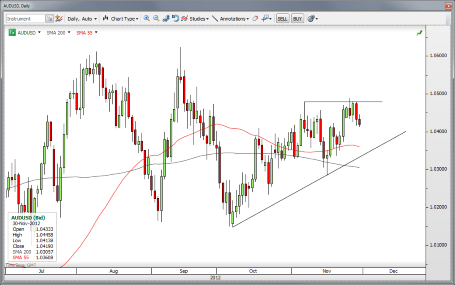EUR/USD has traversed 1.3000 twice in the last hours as the pair seems to be acting as the risk on/risk off barometer for the moment in FX. Meanwhile, is the JPY weakening move getting overextended?
Fiscal cliff likely to lean toward Democrat proposals
The news late yesterday that Republican House leader Boehner was unimpressed with Obama’s first proposals and his negative comments were met with a very modest correction in risk appetite. It appears that the market thinks that this is harmless back and forth that will eventually result in a deal (using the previous debt ceiling debates as a model) and that may indeed be the case, but it is likely to be a deal that leans towards the president’s existing proposal, even if Boehner claimed that Obama’s first proposal wasn’t “serious.”
The Republicans have far more to lose at the 2014 mid-term elections than the Democrats if no deal is pushed through, and their bargaining position is poor. If the Republicans don’t give in, the Democrats can easily play the “class warfare” card and say that the Republicans are ironically to blame for taxes rising for everyone when election time comes around. That is the irony of the situation: do nothing and Republicans lose, do something and they will lose as well. But which loss is more painful for Republicans?
For party unity and consistency of message, a deal is the most painful outcome, but again, for the 2014 mid-term election results, “no deal” might be the most painful. So deal or no deal, Boehner? If the solution leans towards most of Obama’s proposal, we have a drop in the bucket 0.3% of GDP stimulus package, 2% of payroll tax cuts rolling off and tax rising sharply for higher earners and for capital gains.
This may not be a fiscal cliff, but it is certainly a severe fiscal headwind. Mr. Obama’s proposal is likely to go forward, with perhaps some minor smodification that appear to offer little of substance, but some measure of face-saving for Boehner and company.
JPY drops again
The positive production data and low inflation data out of Japan and more importantly, the JPY 880B stimulus package announced overnight and the overall positive mood, has the JPY sharply weaker again and EURJPY touching new highs for the cycle and USDJPY not far away from doing the same. A trend is a trend until the next major event risk comes into view or until the winds change, so let’s see if this move can keep up until this squeeze higher in risk ends or until the 16th of December elections in Japan. I’m concerned that the JPY weakening is overdone in the short term.
AUD remains weak
AUD remains weak in the crosses and was weak overnight after the Treasurer Wayne Swan said that the RBA has room to move on policy. Most are expecting the bank to lower rates 25 bps to 3.00% at next Tuesday’s meeting and the December Australian STIR’s rallied six ticks overnight, further eroding the carry for those holding Aussie longs.
Chart AUD/USD
One of the old rules of thumb is that if an impulse has occurred, but the price doesn’t follow through smartly by the fourth day after that impulse, the likelihood of a reversal rises sharply. AUD/USD is in such a situation as the sickly rally of late saw a run higher that failed to bear further fruit ahead of next Tuesday’s RBA meeting. The next points of focus are the Fibonacci retracement levels just below 1.0400 and then the 200-day moving average coming in around 1.0310. AUD/USD" title="AUD/USD" width="455" height="285">
AUD/USD" title="AUD/USD" width="455" height="285">
(No) Norges Bank FX Purchases
Norges Bank surprised again by announcing that it wouldn’t be making any FX purchases in December after doing the same in November. The reaction thus far is rather muted, but this is nominally NOK supportive, though EURNOK hasn’t been under much pressure as the tail risk removal has stabilized EUR/NOK after its run down in late October/early November.
Looking ahead
There’s not much on the calendar today. We have Canada’s Sep. GDP data and US October Personal Income and Spending data, as well as the Chicago PMI survey up at 1445 GMT.
It’s still a game of risk on/risk off across much of markets, with 1.3000 in EUR/USD as a kind of barometer in risk appetite in FX and perhaps the 55-day moving average a bit above the highs on this run so far for the S&P500. The EU peripheral spreads widened a bit from their tightest levels yesterday as the Italian bond auction saw fairly anaemic demand – and the market may begin to fret next quarter’s heavy issuance needs from Spain and Italy even if they are fairly well covered for now.
Next week we have the details of the Greek official buyback plan and an ECB meeting as well as the usual heavy load of first-week-of-the-month US data, though the next FOMC meeting is not until the following week.
Stay careful out there.
Economic Data Highlights
- Japan November Markit/JMMA Manufacturing PMI out at 46.5 vs. 46.9 in October
- Japan October Jobless Rate out unchanged at 4.2% as expected
- Japan October Overall Household Spending fell -0.1% YoY vs. -0.8% expected and -0.9% in September
- Japan October National CPI out at -0.4% YoY and -0.5% YoY ex Fresh Food and Energy as expected and vs. -0.3%/-0.6% respectively in Sep.
- Japan October Industrial Production out at +1.8% MoM and -4.3% YoY vs.
- UK November GfK Consumer Confidence out at -22 vs. -30 expected and -30 in October
- Germany October Retail Sales out at -2.8% MoM and -0.8% YoY vs. -0.4%/-0.3% expected, respectively and vs. -3.4% YoY in September
- Switzerland November KOF Swiss Leading Indicator out at 1.50 vs. 1.60 expected and 1.64 in October
